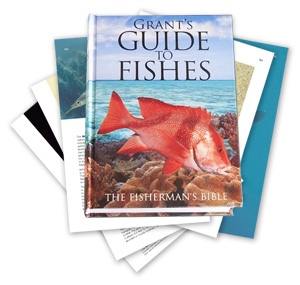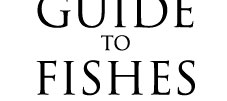Grant's Guide to Fishes has become an Australian institution in fishing circles - it's subtitle "The Fisherman's Bible" was coined by its many loyal followers and readers. It has its origin almost 50 years ago, with the first edition produced in 1965, and since then, 116,500 copies
and an e-book have been produced, making it arguably the longest-running and best-known book on fish identification in Australia.
Although originally Queensland-centric, it now covers all commonly-caught fish across Australia. It contains:
- 1078 fish, sharks & rays
- 1007 colour photographs, many full-plates, and all bled to the page edge for maximum size
- A new pictorial index called "A Guide to the Guide", a photo index of typical types of fish. For example, if you see something like a whiting, and find a fish like it in this index, it leads you to a page of whiting. Therefore, other whiting can be found in that part of the book.
Grant's Guide to Fishes is well-known across
the country, and copies have sold in every state. It is an
institution, and many readers have commented that no other book
comes close to its quality and the ability to identify an
Australian fish. The author, Ern Grant, spent most of his career
as Queensland ichthyologist (fish scientist) and amassed an
enormous knowledge and photographic record of Australian fish
through his lifetime.
ISBN: 978-0-646-14106-0
Format: Hardback
Pages: 880
Weight: 2.5kg
Size: 25cm long, 18cm wide and 5cm deep
|

Thank you to all our loyal readers for your wonderful
support since 1965.
The Grant family has now sold out of print copies of the
final 12th edition of "Grant's Guide to Fishes".
E-book copies are still available, see links
above.
Please check our
Facebook page for stockists still holding print copies and
other news, information and fish IDs.
The editions have run as follows:
First published 1965 (8000 copies)
Second edition 1972 (10000 copies)
Third edition 1975 (14000 copies)
Fourth edition 1978 (20000 copies)
Fifth edition 1982 (28000 copies)
Reprinted 1986 (10000 copies)
Sixth edition 1993 (6000 copies)
Seventh edition 1997 (3000 copies)
Eighth edition 1999 (3000 copies)
Ninth edition 2002 (3000 copies)
Tenth edition 2004 (3000 copies)
Eleventh edition 2008 (5000 copies)
Twelfth edition 2014 (3000 copies)
Twelfth edition e-book (2015) - ongoing
"What a masterpiece of fishology!"
|
Grant's Guide to Fishes is the culmination of a journey which can trace its origins in 1963. Asked by his mentors and seniors in the then Department of Harbours & Marine to produce a guide to commercial fishes in Queensland, Ern Grant wrote a small black-and-white production called Know Your Fishes.
From this humble beginning came the first Guide to Fishes, produced also by the Queensland Government, and starting in 1965 with its first edition. This book had no photographs, but relied on the then-common method of identification through painstaking drawings by delineators (very skilled draftsmen/artists). However, Ern's contacts said: "Surely even a poor photograph is better to identify a fish than a great drawing?" And so began a lifetime of work in collecting a massive range of fish - in photographs. Many of these were hand-captured by net, line or chasing down over sand, mud or coral reefs and collecting by hand-scoop.
The second edition in 1972 received the benefit of the first set of these photographs, and the Government editions ended in 1982 with the fifth edition of Guide to Fishes.
Initially unable to gain permission to update the Government Guide to Fishes once in retirement, Grant went on to produce a brand new book, Fishes of Australia privately in 1987, and Corals of the Great Barrier Reef in 1991. This new private production of the Guide, as Grant's Guide to Fishes, first appeared in 1993 with the sixth edition, and it and later editions achieved the same measure of public acceptance as before.
Each edition is edited to take advantage of new technology,
new photographs, and updated information on fish identification,
groupings and maximum sizes. |




![]()











